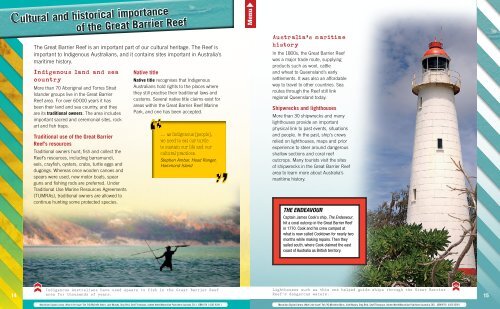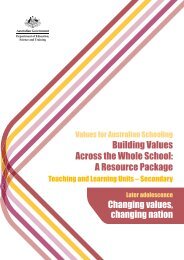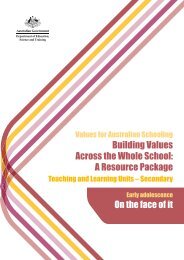GREAT BARRlER REEF - Saint Ignatius' Moodle Community
GREAT BARRlER REEF - Saint Ignatius' Moodle Community
GREAT BARRlER REEF - Saint Ignatius' Moodle Community
You also want an ePaper? Increase the reach of your titles
YUMPU automatically turns print PDFs into web optimized ePapers that Google loves.
The Great Barrier Reef is an important part of our cultural heritage. The Reef is<br />
important to Indigenous Australians, and it contains sites important in Australia’s<br />
maritime history.<br />
Indigenous land and sea<br />
country<br />
More than 70 Aboriginal and Torres Strait<br />
Islander groups live in the Great Barrier<br />
Reef area. For over 60 000 years it has<br />
been their land and sea country, and they<br />
are its traditional owners. The area includes<br />
important sacred and ceremonial sites, rock<br />
art and fish traps.<br />
Traditional use of the Great Barrier<br />
Reef’s resources<br />
Traditional owners hunt, fish and collect the<br />
Reef’s resources, including barramundi,<br />
eels, crayfish, oysters, crabs, turtle eggs and<br />
dugongs. Whereas once wooden canoes and<br />
spears were used, now motor boats, spear<br />
guns and fishing rods are preferred. Under<br />
Traditional Use Marine Resources Agreements<br />
(TUMRAs), traditional owners are allowed to<br />
continue hunting some protected species.<br />
Native title<br />
Native title recognises that Indigenous<br />
Australians hold rights to the places where<br />
they still practise their traditional laws and<br />
customs. Several native title claims exist for<br />
areas within the Great Barrier Reef Marine<br />
Park, and one has been accepted.<br />
… as Indigenous [people],<br />
we need to eat our turtle<br />
to sustain our life and our<br />
cultural practices.<br />
Stephen Ambar, Head Ranger,<br />
Hammond Island<br />
Australia’s maritime<br />
history<br />
In the 1800s, the Great Barrier Reef<br />
was a major trade route, supplying<br />
products such as wool, cattle<br />
and wheat to Queensland’s early<br />
settlements. It was also an affordable<br />
way to travel to other countries. Sea<br />
routes through the Reef still link<br />
regional Queensland today.<br />
Shipwrecks and lighthouses<br />
More than 30 shipwrecks and many<br />
lighthouses provide an important<br />
physical link to past events, situations<br />
and people. In the past, ship’s crews<br />
relied on lighthouses, maps and prior<br />
experience to steer around dangerous<br />
shallow sections and coral reef<br />
outcrops. Many tourists visit the sites<br />
of shipwrecks in the Great Barrier Reef<br />
area to learn more about Australia’s<br />
maritime history.<br />
The Endeavour<br />
Captain James Cook’s ship, The Endeavour,<br />
hit a coral outcrop in the Great Barrier Reef<br />
in 1770. Cook and his crew camped at<br />
what is now called Cooktown for nearly two<br />
months while making repairs. Then they<br />
sailed south, where Cook claimed the east<br />
coast of Australia as British territory.<br />
14<br />
Indigenous Australians have used spears to fish in the Great Barrier Reef<br />
area for thousands of years.<br />
Lighthouses such as this one helped guide ships through the Great Barrier<br />
Reef’s dangerous waters.<br />
15<br />
Macmillan Digital Library: What’s the Issue? Set 2 © Michelle Atkins, Julie Murphy, Greg Reid, Geoff Thompson, Ashten Warfe/Macmillan Publishers Australia 2011 ISBN 978 1 4202 9209 1 Macmillan Digital Library: What’s the Issue? Set 2 © Michelle Atkins, Julie Murphy, Greg Reid, Geoff Thompson, Ashten Warfe/Macmillan Publishers Australia 2011 ISBN 978 1 4202 9209 1







